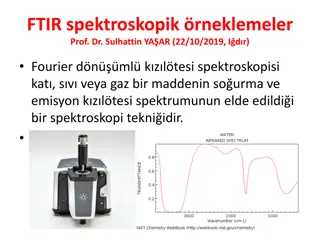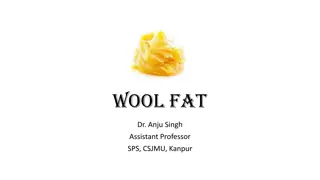Alcohol as a Drug
Preliminary training for the DEC program, covering an overview of alcohol, common types of alcohols, physiological processes of absorption, distribution, and elimination in the body, and dose-response relationships.
1 views • 32 slides
Functional Groups in Organic Chemistry
Functional groups in organic chemistry are specific groups of atoms within molecules that determine the chemical properties of the compound. This content provides visual representations and descriptions of various functional groups such as alkanes, alkenes, alcohols, aldehydes, acids, and esters. Le
0 views • 38 slides
The Binding Role of Alcohols and Phenols in Drug Molecules
The role of alcohols and phenols in drug molecules is crucial as they are frequently involved in hydrogen bonding interactions. By creating analogues with modified functional groups, such as ethers and esters, the importance of specific groups can be determined. The presence or absence of hydrogen b
2 views • 20 slides
Overview of Lipids: Classification and Biological Importance
Lipids are organic substances that play a crucial role in biological systems. They include simple lipids, complex lipids like phospholipids and glycolipids, and derived lipids. Simple lipids are esters of fatty acids with various alcohols, while complex lipids are sub-classified based on the type of
2 views • 38 slides
Organic Chemistry Reactions Overview
This content covers various aspects of organic chemistry reactions, including the oxidation of alcohols with potassium dichromate, the solubility of molecules in water, and the oxidation of propan-1-ol to form aldehydes or carboxylic acids. It also explores the oxidation of butan-2-ol and the suitab
1 views • 9 slides
Oxidation of Alcohols in Carbon Chemistry
Oxidation of alcohols involves either adding oxygen or removing hydrogen in carbon compounds, leading to the production of aldehydes, ketones, and carboxylic acids. Primary alcohols can oxidize further to produce aldehydes and carboxylic acids, while secondary alcohols form ketones. Tertiary alcohol
1 views • 13 slides
Alcohols: Classification and Nomenclature
Alcohols are categorized into aliphatic and aromatic types based on the structure of the hydroxyl group. Aliphatic alcohols have the OH group attached to an aliphatic carbon chain, while aromatic alcohols have it in the side chain of an aromatic hydrocarbon. Further classification includes monohydri
0 views • 11 slides
Overview of Alcohols: Classification, Preparation, and Properties
Alcohols are compounds containing hydroxyl groups, classified based on chain type and number of hydroxyl groups. They can be aliphatic or aromatic, monohydric or polyhydric. Classification also includes primary, secondary, and tertiary alcohols based on carbon hybridization with the hydroxyl group.
1 views • 22 slides
Effective Strategies for National 5 Chemistry Extended Answer Questions
National 5 Chemistry Paper 2 typically includes two open-ended questions worth 3 marks each, designed to test your understanding of key chemical principles. This guide offers advice on how to approach and excel at these questions, emphasizing the importance of careful reading, application of chemica
0 views • 24 slides
Alcohols in Lipid Structures and Their Importance
Delve into the world of derived lipids alcohols, such as glycerol, sphingosine, and cholesterol, which play vital roles in various forms of lipids. Learn about the classification of alcohols involved in lipid structures and their significance as derived lipids. Discover how glycerol, a polyol, acts
0 views • 67 slides
Overview of Acyl Chlorides in Organic Chemistry
Acyl chlorides, also known as acid chlorides, are important compounds in organic chemistry. They can be prepared from carboxylic acids and thionyl chloride, and are reactive towards various nucleophiles leading to the formation of carboxylic acid esters, primary and secondary amides. Acyl chlorides
0 views • 5 slides
Essential Oils: Properties, Chemistry, and Uses
Explore the fascinating world of essential oils, from their properties and uses to the chemistry behind their distinctive aromas. Learn about terpenes, key components in essential oils, and discover their modern applications in cosmetics, cleaning, flavors, and more. Understand what essential oils a
0 views • 36 slides
Alcohol Oxidation in Organic Chemistry
Explore the oxidation of alcohols in organic chemistry through a series of experiments involving primary, secondary, and tertiary alcohols. Learn how different alcohols react and identify the products of oxidation reactions. Understand the distinctions between aldehydes, ketones, and the classificat
0 views • 31 slides
Fourier Transform Infrared (FTIR) Spectroscopy Examples by Prof. Dr. Sulhattin YAŞAR
Fourier Transform Infrared (FTIR) spectroscopy is a technique used to obtain the absorption and emission spectra of solid, liquid, or gas substances. This content provides characteristic absorption peaks for various functional groups, such as alkane, alkyl, alkenyl, alkynyl, aromatic compounds, alco
0 views • 15 slides
Tank Car NAR Data Breakdowns 2017 Preliminary Overview
Preliminary data breakdowns for Tank Car NAR incidents in 2017 sourced from PHMSA and Canadian railroads. Details on incident sources, gaps in Cause Codes, reductions in NARs since previous years, top commodities involved, and multiple NAR occurrences from the same origin points. Graphs depict trend
0 views • 16 slides
Organic Chemistry: Functional Groups and Naming Rules
Delve into the world of organic chemistry with a focus on functional groups like alcohols, ethers, aldehydes, and ketones. Explore the rules for naming these compounds, understanding their structures, and how they impact the properties of molecules. From alcohols with hydroxy groups to ketones conta
0 views • 21 slides
Acid-Catalyzed Reactions of Alcohols: SN2 and SN1 Mechanisms
The acid-catalyzed reactions of alcohols involve SN2 and SN1 mechanisms where protonated alcohols react with RX. In the SN2 mechanism, a nucleophile attacks a protonated 1o alcohol, leading to inversion. On the other hand, in the SN1 mechanism, a carbocation intermediate is formed, and a nucleophile
0 views • 12 slides
Alcohols: Classification, Nomenclature, and Uses
Alcohols are organic compounds with an -OH functional group attached to a carbon atom. They are classified as primary, secondary, or tertiary based on the carbon the -OH group is bonded to. The IUPAC nomenclature for alcohols involves changing the ending of an alkane to -ol. Alcohols like methanol,
0 views • 11 slides
Alkenes, Alcohols, and Carboxylic Acids in Organic Chemistry
Alkenes are hydrocarbons with a double carbon-carbon bond, reacting uniquely due to their functional group. Alcohols and carboxylic acids also have distinctive properties and reactions, important in organic chemistry studies. Learn about their structures, formulas, reactions with other compounds, an
0 views • 4 slides
Diverse World of Proteobacteria
Proteobacteria, a phylum of Gram-negative bacteria, exhibit wide morphological and metabolic diversity with clinical, environmental, and industrial relevance. This phylum, boasting the highest number of cultured representatives, is divided into various groups based on 16S rRNA sequencing. From N2-fi
0 views • 49 slides
Wool Fat: Properties, Sources, and Uses
Wool fat, also known as lanolin, is a pale yellow substance extracted from raw wool. It contains cholesterol, alcohols, and fatty acids and is insoluble in water. Prepared from sheep wool, wool fat is used in creams and ointments as an emollient base. Its purification involves processes like crackin
0 views • 8 slides
Azeotropic Distillation Sequences in Chemical Engineering
Azeotropic distillation columns play a crucial role in separating complex mixtures containing azeotropes like alcohols, ketones, ethers, acids, and water. By studying phase diagrams, residue and distillation curves, and process flow diagrams, engineers can grasp the nuances of product composition co
0 views • 22 slides
Glycosides: A Comprehensive Overview
Glycosides are compounds that undergo hydrolysis to yield sugar and non-sugar parts. The aglycone is also known as the genin, while the sugar part is the glycone. They are soluble in water and alcohols, with different solubility properties for glycone and aglycone parts. Glycosides can be hydrolyzed
0 views • 12 slides
Overview of Cleaning Agents and Disinfectants in Healthcare Settings
Cleaning and disinfection play a crucial role in maintaining hygiene and preventing infections in healthcare settings. Cleaning involves the removal of foreign material from surfaces, while disinfection kills microorganisms. Hospital-grade disinfectants like alcohols, chlorine, phenolics, and hydrog
0 views • 13 slides
Sterilization, Asepsis, and Antisepsis in Ancient and Modern Perspectives
Sterilization is the process of eliminating all microorganisms from an object or surface. Disinfection targets pathogenic microbes without spores. A good antiseptic/disinfectant should be chemically stable, affordable, non-staining, cidal, active against various pathogens, and able to spread effecti
0 views • 19 slides
Chemical Methods of Disinfection in Healthcare
Disinfectants play a crucial role in eliminating pathogenic bacteria from surfaces in healthcare settings. They come in various forms with different spectra of activity. This article delves into the classification of disinfectants, their spectrum of activity, properties required for chemical agents,
0 views • 14 slides

























